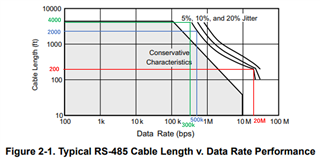Other Parts Discussed in Thread: SN65HVD22
Tool/software:
Hi Team,
I have a question about SLLA628.
https://www.ti.com/lit/an/slla628/slla628.pdf
There exists a tradeoff between speed and maximum bus length.
If 5% jitter is acceptable, is my understanding correct that this device supports the following specs?
Max cable length is 200ft(60m) at 20Mbps.
Max cable length is 2000ft(600m) at 500kbps.
Max cable length is 4000ft(1200m) at 300kbps

Section 2.2.3 says that “further complicate the trade-off is the question of network topology”.
This product supports 256 nodes.
Are the above three specs of data rate vs. cable length met at 256 nodes?

Best Regards,



